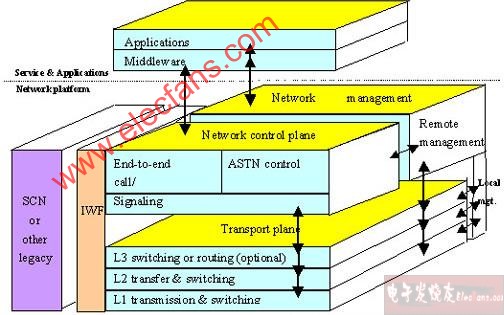Research on Next Generation Network Architecture and Related Issues Figure 1 NGN functional model 5. NGN network mobility research Today's networks, whether mobile or fixed, are evolving to IP-based networks to support multimedia services. With the improvement of network capabilities, users can enjoy more and more services. One development trend is that users who access the network through any technical means should receive the same service. This situation is not uncommon in fixed access networks. Such as XDSL, wired cable access, etc. However, at present, the network still treats users differently. Different users use different network service systems and cannot communicate with each other. This is a serious flaw for users who want to move between networks with different access technologies in the most convenient way. The key step for future service provision is to provide users with stable and reliable services, that is, when users use different access technologies, they are treated as the same entity, so that they can consistently enjoy the required services across the current network boundaries. 1) Interoperability of various access methods The key to the future network to provide a free and broad service environment is to achieve the coordination and coexistence of various access technologies, solve the interconnection between various technologies to obtain interoperability, and Integration is achieved on this basis. At present, the main access systems considered include the following: Digital Audio Broadcasting (DAB) Nomadism Mobility Mobility means that the user can change the network access point as the location moves without interrupting the current session, but in some cases there may be a short interruption of the call. Roaming roaming means that users can access network services in a non-home network. 3) Mobility requirements for NGN networks To achieve more transparent fixed-wireless broadband communications and mobility across different access technologies requires major changes to the current network structure and further expansion of the network functions of the control layer, mainly including: 7. Conclusion This article summarizes the current research results and latest progress of the ITU-TNGN2004Project in NGN, including the characteristics and functional models of next-generation networks, the problems that the next-generation networks need to analyze and solve, and how next-generation networks support mobility.
This kind is Bagged Vacuum Cleaner. It is a Vacuum Cleaner with high suction. It has accessory storage on the unit. It also has safety valve to protect motor. It's a vacuum cleaner with top quality with gorgeous looking. Its airflow control is on handle and speed control is on unit. It also has automatic cord rewinder,then you will use very easily.
Bagged Vacuum Cleaner Dust Bag Vacuum Cleaner, Vacuum Cleaner With Bag, Bagged Vacuum Cleaner, Bagged Upright Vacuum Cleaner Ningbo ChinaClean Household Appliances Manufacture Co., Ltd. , https://www.chinaclean-elec.com
1. Introduction With the evolution of network architecture and the development of broadband technology, the evolution of traditional networks to next-generation networks is unstoppable. The next generation network will have a broader business scope. Its main goals are: support real-time multimedia services, reduce the time to market for services, support multiple access methods and multiple access terminals, support mobility, ensure the smooth evolution of existing networks and have economical and scalable networks structure.
At present, many international standardization organizations are actively involved in the research of next-generation network technologies, especially the ITU-TSG13 study group, leading the establishment of the NGN2004Project to study NGN-related technologies. At the 2001-2004 study period meeting held in Geneva in November 2002, next-generation network technology became the focus of discussion at the meeting. During the meeting, not only did NGN seminars be organized, but also joint discussions with the Special Research Group (SSG) At the meeting, a number of research results were obtained, including analysis of the characteristics of NGN, the functional model of NGN, the mobility requirements of NGN, and the problems that NGN needs to study and solve.
2. Characteristics of next-generation network Next-generation network is a very broad category, which aims to reform the infrastructure of the existing telecommunications network and information industry to support a wider range of services. Its characteristics are:
Separate call control and bearer separation based on packet transmission;
Support various businesses;
Interoperable with existing networks;
Support mobility
3. Functional model of NGN The next-generation network functional model is shown in Figure 1. It contains four levels, and each level can contain sub-layers or other parts. Different planes can communicate with each other as follows:
ï¼Application plane: It consists of two parts: application and middleware. The middleware is some general software defined by GII. Typical middleware components such as authentication, billing, directory, security, browsing, searching, navigation, format conversion, etc. The application plane not only provides services to mass users, but also provides service support to operation support systems and service providers.
-Network control plane: provides end-to-end call / session control, control of the underlying automatic switched transport network (ASTN), and signaling processing functions.
-Transmission plane: Contains the lower three layer functions of the network, the first layer switching and transmission, the second layer switching and switching, and the third layer switching and / or routing functions (optional).
-Management plane: Provide remote and local management capabilities.
In addition, the NGN system also needs to have an interworking function (IWF) for interworking with existing circuit-switched networks. 
4. Problems that need to be analyzed and solved by NGN network
4.1 The NGN general framework model studies the NGN general system principles to reflect the separation of control functions and resources, services, and transmission in NGN. Study the NGN network functional system model, which will provide guidelines on how to use functional methods to define the NGN functional system.
4.2 NGN network function system and protocol focus on using a common reference model to identify the communication process required to support NGN within or between operators; define the interworking functions required by traditional terminals; define the BICC protocol for the relay level; Determine how to support end-to-end services, call control, and user mobility across heterogeneous networks; define functional requirements for software upgrade mechanisms, redundancy, and version negotiation and management in NGN terminals, etc.
4.3 Service quality issues
QoS is an end-to-end problem. It mainly studies how different end systems implement end-to-end QoS negotiation, defines upper-layer protocols to control lower-layer QoS parameters, and QoS guarantee measures for the transmission plane and access plane. Among them, the control layer has to implement the QoS control of the lower layer from two levels: one is to connect the QoS mechanism between the upper and lower layers through the "vertical" protocol between the upper and lower planes, and the other is to implement different domains at the "horizontal" level Or QoS control and negotiation between networks. In general, the research content mainly includes:
QoS level of end-to-end telephone service;
QoS level of end-to-end multimedia services, define its framework, and study QoS registration methods;
How to use the low-level QOS mechanism of the network to obtain the high-level QOS research on the low-level QoS mechanism;
Study the low-level QOS control mechanism of inter-operator networks;
Study the end user rules of QOS.
4.4 Business Plan
An important aspect of NGN is the separation of service control from the underlying network. To achieve this goal, the service plane needs to provide open interfaces to third-party service providers, such as ParlayAPI and / or proxy servers. In addition, the service must be able to support location mobility , That is, users can still enjoy services when roaming to other networks. Specific research contents include:
Define the business control architecture;
Study how to implement business usage during roaming and business interconnection between different networks.
Study how to realize user customization and management of business;
The impact of user mobility on the business plane.
4.5 Network management Since the NGN network is composed of fixed network, mobile network, IP network and access network, etc., which leads to the complexity and challenge of such network management, it is necessary to study and improve the core network management system; define applicable Basic network management services and interfaces for NGN requirements (fault management, performance management, customer management, billing / account management, business volume and routing management, etc.); apply new network management system concepts and new network management technologies, such as TML, etc.
4.6 Security In NGN networks, network security is related to the network system, QoS, network management, mobility, billing system, and accounting system, so it is necessary to develop the NGN security system and security guidelines, as well as the development of NGN Security protocol and API interface.
4.7 Generalized mobility
Broad mobility means that when users use different access technologies, they will be treated as a single customer, allowing users to use and manage their services across existing network boundaries. The user's mobility requirements include: the user has the ability to change the access point or terminal, and as a mobile / nomadic user; the user can use various access technologies to access the network from any network access point; the user can get continuous Services and network applications. These services and network applications can be provided by network operators, service providers, or third parties. For mobility, the business capabilities of the network should be considered to support personal mobility, terminal mobility, and their combination. In order to support the above requirements, ITU in NGN research should fully consider the service requirements, requiring the network to have identification (IdenTIficaTIon) and authentication (authenTIcaTIon mechanism, access control and authorization (Authorization) function, location (Location) management, support terminal Or session (session) IP address allocation and management functions, support user VHE management functions, support user management functions, etc.
At present, users can roam in the public wireless access network with the same structure, but roaming in the fixed network is greatly restricted. Mobility is only applicable to the same network environment. The development of the network requires that users can implement different fixed connections in the future. Mobility between the access network and the public wireless access network (for example, from UMTS to WLAN), and the same services can be obtained. To achieve this goal, interoperability of various access methods and core network interoperability are required. There have been some articles on specific interoperability, such as WLAN_UMTS, but there is no globalization yet.
Various public cellular systems, such as W-CDMA, CDMA-2000, GPRS, etc.
A fixed access network that seamlessly connects to mobile systems, including XDSL, cable, various narrowband access, and WLAN.
The access technologies and bandwidth capabilities used by the above systems are different, so it is impossible to expect a multimedia terminal to support various accesses at the same time, but users can access network services through multiple terminals to achieve mobility in heterogeneous environments. In addition to supporting user mobility, it should also support business mobility. In general, user requirements for mobility include:
Users can change the access point or terminal, but this function is only applicable to users with mobile or roaming rights.
Users can access the network from any node, which requires the network to have certain authentication capabilities.
Users can get consistent services, but may be limited by the user ’s current location, so cooperation between the network provider and the service provider is required.
Network, business and application systems and even third-party business and application systems should know whether users are available and reachable.
2) Service level The following lists several service levels that should be considered for mobility:
Mobility of individuals and terminals:
Personal mobility means that the user can change his terminal; terminal mobility means that the user moves with his terminal. The so-called user changes its network access point means that in personal mobility, the user changes the location or terminal or access technology. In terminal mobility, the user changes the location or access technology, but keeps the same terminal.
Swimming allows users to change the network access point as they move. When the access point changes, the user's session will be interrupted and then re-established.
Some people may think that the above requirements can be solved by simply extending the current network. The following example illustrates that this view is not correct. For example, a user accesses the network through ADSL and authenticates, so he starts a multimedia session. After a while, the user converts to UMTS access and authenticates, and then starts a new multimedia session. The user information on the network is different, so mobility and stable services cannot be provided, and authentication of different identities, logins, and passwords is required in both modes, and due to the "always-on" feature of the XDSL access mode, even users In the UMTS communication mode, system resources are still occupied, resulting in a waste of resources. If the application roaming function and multi-access single user information can be supported, the functions of authentication, authentication, and arbitration for cross-network access can be simplified.
Authentication and authentication mechanism From the user's perspective, in order to avoid duplication of the control mechanism, this function can be considered as already defined in the current network's authentication and authentication mechanism.
The results of the access control and authentication functions determine whether to accept user connection requests. The next step is to adapt the access network structure to mobile users, including the QOS level of user connections. This level is limited by user conditions and access network technology. Decide.
Location management Location management includes network location and geographic location management.
One of the solutions for IP location allocation and management is to let users use fixed IP addresses, which requires a special mobility management solution to grant users local IP addresses.
User environment management The user environment is defined as the entire "access network + terminal". The user environment determines the scope of mobile users to obtain services. The function of this function is to abstract the main user environment characteristics into data, which is used to provide related services for mobile users. This function is very important for operating between different types of environments. Because the same environment has the same meaning for all users, no such data is needed. The wider network environment of NGN makes more and more operations between different types of environments. This function realizes the first step of the virtual home environment, that is, the characteristics of the user environment are determined, so that the service is adapted to the current user environment.
User information management The above functions rely on some user data-personal data or network data. The storage and update of these data is completed by the user information management function.
Access user data
This feature provides filtering of user data, that is, restricting certain interrogating entities from obtaining certain user data, thereby ensuring user data privacy.
4) Standardization progress in NGN mobility
3GPP and 3GPP2 focus on IMS evolution. The mobility management provided by them is only effective for their own systems. To achieve IMS access between 3GPP and 3GPP2, coordination and interworking between two multimedia systems are required.
IETF is studying mobile IP technology to achieve macro mobility between routers, but how to apply mobile IP to other situations (such as wireless networks) is a question worth considering.
The SSG in ITU-T is responsible for the coordination and centralization of IMT2000, and has begun to write requirements.
NGN is a long-term goal, and there are many unsolved technical and standard system issues in this process. With the continuous improvement of information technology and equipment, users will surely get more extensive and higher-quality services in the future network. 







